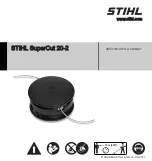
35
User Manual
34
Armed with this information, you may be able to determine that the charger is not work-
ing properly if:
a) Either the on-charge voltage for the battery pack or on-charge voltage for each
battery fail to reach the equivalent of 2.5 volts per cell times the number of cells
connected in series.
b) The on-charge voltage increases and then decreases (with charger still
charging), and if the on-charge voltage of each battery does not vary by more
than the values shown in Table II for 6, 8, or 12 volt batteries; either variation
from pack average or variation from highest to lowest.
c) If the battery pack on-charge voltage reaches the equivalent of 2.60 volts per
cell (the maximum in Table-I), and the charger does not terminate the charge
after 1-3 hours. If you found that your charger is not working properly, keep in
mind that your batteries may still be good. Flooded lead-acid batteries can be
brought back to full capacity with a full charge.
If you decide to purchase a new charger, look for a programmable charger with a se-
lection of multiple charge algorithms. Deep cycle batteries from various battery man-
ufacturers require different charge characteristics to deliver optimum performance
and life. Most charger manufacturers provide programmable chargers with selectable
charge algorithms designed for each battery manufacturer’s products. Using the bat-
tery manufacturer’s recommended charging procedure will optimize battery perfor-
mance and life of your battery pack.
After you fully charge the batteries with your new charger, you can always take specif-
ic gravity readings for each battery with a hydrometer to determine if the battery is at
a full state of charge. Several cycles of charging and discharging with the new char-
ger may be required to return the battery pack to peak capacity. For a more detailed
version of this charger diagnostic procedure or more information on flooded lead acid
batteries or specific gravity readings for batteries, visit
7
WHAT TO EXPECT FROM
YOUR DEEP-CYCLE
BATTERY
●
A brand new deep-cycle battery will deliver less than the rated capacity. This is
normal as it takes cycling and use for a deep-cycle battery to reach maximum ca-
pacity.
●
US Battery’s batteries take 30 to 80 cycles to cycle up to peak capacity.
●
When operating batteries at temperatures below
80°F (27°C)
they will deliver
less
than the rated capacity. When operating batteries at temperatures
above 80°F
(27°C)
they will deliver more than the rated capacity but the battery life will be re-
duced.
Refer to the “Battery % Capacity vs Temperature” graph below.
●
Just like the expected lifespan of anything else, the life of a battery is difficult to
predict, as it is a function of many variables: charging algorithms, application and
use, maintenance, temperature, and purity of water used, to name a few.
BATTERY % CAPACITY VS TEMPERATURE
Battery Temperature (ºC)
Battery Temperature (ºF)
30%
30%
-40
-40
-29
-18
-7
4
16
27
38
49
60
-20
0
20
40
60
80
100
120
140
40%
40%
50%
50%
60%
60%
70%
70%
80%
80%
90%
90%
100%
100%
110%
110%
120%
120%
DIAGRAM 16
Содержание US 13-4-1 XC2
Страница 1: ...USER MANUAL DEEP CYCLE BATTERY ...










































